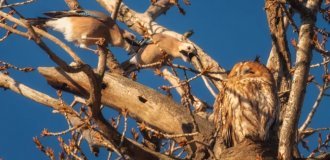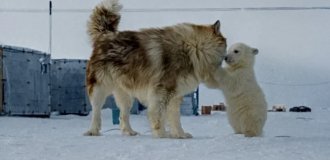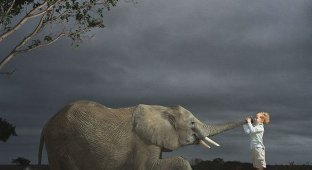Let's continue the stories about animals. Taking into account your comments in the last post, I decided to review animals by continent. Let's start with Europe and most likely end with Antarctica and Madagascar (I know that this is not a continent, but an island. It just has too endemic a fauna, so it deserves a separate story.) In the posts we will consider only mammals. I hope you like my selection.
Muskrat


Pyrenean muskrat

Russian muskrat

The muskrat is a close relative of the mole. For its ability to swim beautifully and dig long underground holes, it received another name - water mole. This animal comes to land only in cases of extreme necessity. Its appearance is a bit unusual, especially its elongated snout and webbed, clawed feet.
Once upon a time, the muskrat was common not only in Russia, but also in many European countries. Now there are only 2 species of this animal left in the world - the Russian muskrat (Latin Desmana moschata) and the Pyrenean muskrat (Galemys pyrenaicus).
The animal itself is small. It grows no more than 45 cm in length, half of which is in the powerful tail. The muskrat weighs about 500-550 grams.
[media=https://www.youtube.com/watch?v=TuuRmvaO_RE]
Gibraltar Magot





The magot, or Barbary monkey, or Maghreb macaque (lat. Macaca sylvanus) is the only monkey living wild in Europe (in Gibraltar). In Gibraltar there is a belief that as long as at least one monkey lives on the rock, the city will remain British. Since 1855, the Gibraltar Magots have been under the official patronage of the British Navy.
Magoth is depicted on the Gibraltar 5p coin. On the other side is Queen Elizabeth II.
[media=https://www.youtube.com/watch?v=sfAluODDrzc]
Raccoon dog



The (Ussuri) raccoon dog, or Ussuri raccoon fox, or Ussuri raccoon, or raccoon (lat. Nyctereutes procyonoides) is a predatory omnivorous mammal of the canine (canine) family. Strictly speaking, it is not endemic to the European continent, but from 1927 to 1957, about 10 thousand raccoon dogs were brought and released in 76 regions of the former USSR to enrich hunting grounds. They did not take root in the Asian part of the country, but in the European part they quickly multiplied and began to spread further, including to the countries of Western Europe, penetrating Finland, Estonia, Sweden, Poland, Romania, the Czech Republic, Germany and France.
[media=https://www.youtube.com/watch?v=iNGxopfIUXE]
European forest cat



The Central European forest cat is much larger than the steppe or domestic cat and has higher fur. In appearance it is very similar to a domestic cat, but differs from it in its larger size and color - gray, smoky or brown, dark stripes along the ridge, more uniform (without stripes) and lighter colored fur on the sides, a thick fluffy tail with numerous transverse ring stripes and a dark, as if chopped off, tassel (in domestic cats, the color can be of very different colors, stripes along the ridge are most often absent, the color of the fur on the sides is of any color, the tail is thin and pointed at the end of any color). The gestation period is 63 to 68 days, and 2 to 4 kittens are usually born.
[media=https://www.youtube.com/watch?v=pOAmfUGX2Cg]
Dressing



The bandage is a small animal, slightly smaller than a ferret. The body length is from 30 to 40 cm, with almost half falling on the tail. The weight of the largest adult individuals reaches 730 g, the average weight of females is only 300–400 g. The bandage has a physique typical of most representatives of the mustelid family. An elongated body, a long tail, short legs, a small head - these are the main characteristics of its appearance. However, the bandage can be easily distinguished from its closest relatives by its specific color. The upper body and back of the animals are dark brown with numerous bright yellow spots and stripes. The underparts and neck are black. The muzzle is also black, with a beautiful pattern of wide white stripes.
[media=https://www.youtube.com/watch?v=qkJ6JOdWa7A]
Common Genet



Geneta vulgaris is one of the largest representatives of its genus. The average size of her body is 50–60 centimeters with a weight of up to 2 kilograms; most other genets rarely grow to half a meter in length. The tail of the predator is slightly shorter than the body. They were introduced to the Iberian Peninsula and southern France. Inhabits forest and shrub areas, and also lives in the mountains. In the Pyrenees, the presence of the common genet has been proven at an altitude of about 2000 m. It is noteworthy that before the domestication of cats, common genets were used in human settlements to control pests (mice, etc.).
Horseshoe bats



Horseshoe bats - representatives of this family of bats are easily distinguished from other bats by peculiar outgrowths on the nasal part of the head. However, these features of the structure of the muzzle are easy to see only when holding the animal in your hands, and not when the horseshoe bat flies out to hunt and flashes in the dense twilight. The silhouette of the animal also has features. The posterior caudal section of the membrane is not extended downwards in a wedge-shape, as in other bats, but is cut off more or less evenly.
[media=https://www.youtube.com/watch?v=r1ENexQBqr0]



The Common Eurasian is a species of the jerboa family, an order of rodents.
It lives in Russia from the sands of the lower reaches of the Don and the western Caspian region to the eastern part of the Zaisan basin and the left bank of the Irtysh.
The body length is 9-12 cm, the hind foot is 4.6-5.1 cm. The head is rounded, the muzzle is shortened, and the ears are relatively small. The hind limbs are three-toed. We sell women's trousers of excellent quality. The hair at the end of the tail forms a small brush of dark color. The color of the upperparts is from brownish-gray to buffy-brownish, the belly is white, the hair on the underside of the toes is dark.
Active at night. It runs poorly and prefers to hide among vegetation. With the onset of winter, it goes into hibernation and awakens with the beginning of the growing season. Lives in burrows, the number of entrances is from 1 to 6. Pregnant females are found from mid-March to mid-August.
And it has a cool name :-)
[media=https://www.youtube.com/watch?v=rgW6n_S1g_s]
Sony




Dormice are small and medium-sized rodents, externally similar to mice (terrestrial forms) or squirrels (arboreal forms). Body length is from 8 to 20 cm. The tail is usually slightly shorter than the body - 4-17 cm; in most dormouse it is densely pubescent, in selevinia and mouse-like dormouse it is half naked. The eyes and ears are well developed, the latter are rounded, without tufts at the ends. The limbs are relatively short. There are 4 fingers on the forelimbs, and 5 on the hind limbs. The first finger of the hind limb sometimes lacks a claw; on the remaining fingers the claws are well developed: they are short but very sharp. With the exception of selevinia and mouse-like dormouse, all other species have developed plantar calluses. The hairline is thick and soft, but low. The color of the back is uniform, from gray to ocher-brown.
[media=https://www.youtube.com/watch?v=81cQ6MN4Z2I]
Crested porcupine




The crested porcupine is a mammal from the order Rodents, and is the most famous species in its family Porcupines. This animal is known to everyone thanks to its original appearance - huge needles covering the entire upper part of the body. Its Latin name Hystrix cristata is translated into Russian as crested porcupine. This is due to its appearance, namely with a kind of “comb” located on the animal’s head.
The crested porcupine is considered the third largest rodent in the world, ahead of only the South American capybara and beaver.
Mole rat




The common mole rat is completely devoid of vision, instead it has tactile hairs, a well-developed sense of smell and hearing. This is enough for the animal to live a normal life, during which it almost never sees sunlight. For many land owners, the mole rat has become a real punishment, because it is capable of digging up the entire planting area and even affecting the stability of the buildings located there.
The maximum length of these rodents reaches 32 cm, and their weight is 700 g. They have an elongated body in the shape of a cylinder, a short neck, paws and tail, and a head flattened at the top. The animals' ears are barely noticeable, and their eyes are hidden under the skin and completely atrophied. The color of different individuals may have some differences.
[media=https://www.youtube.com/watch?v=UBcltO1FPNU]
Lynx



[media=https://www.youtube.com/watch?v=qdoBzOeCKm4]
The lynx is a typical cat, although the size of a large dog, which it partly resembles with its shortened body and long legs. The head of a lynx is very characteristic: relatively small, round and very expressive. Lynx cats are distinguished from other cats by their short tail and tufts at the ends of their ears. The body weight of a lynx is from 5 to 30 kg.
Lynx is the northernmost species of the cat family. In Scandinavia it is found even beyond the Arctic Circle. It was once quite common throughout Europe, but by the mid-20th century it was exterminated in most countries of Central and Western Europe. Successful attempts have now been made to revive the lynx population.
In Russia, the lynx is found in dense, heavily cluttered, overmature coniferous forests up to Kamchatka and Sakhalin, where it penetrated relatively recently. Lynx is also found in the Carpathians, the Caucasus, and Central Asia. It is scarce everywhere.
Lynx is found in central Russia, Georgia, Estonia, Finland, Sweden, Poland, Czech Republic, Hungary, Romania, Spain, Serbia, Macedonia, Slovenia, Slovakia, Belarus, Croatia, Albania, Greece, Lithuania, Latvia, Ukraine (in the Carpathians) , Armenia, Azerbaijan and Kazakhstan.
In the Scandinavian tradition, the lynx was the sacred animal of the goddess Freya. It was believed that lynxes were harnessed to her chariot. The ancient Greeks believed that the sharp gaze of a lynx was capable of piercing through opaque objects.
[media=https://www.youtube.com/watch?v=RSeS1TQYRnE]
Bison



Bison are the largest wild animals in Europe. Representatives of artiodactyl animals, once almost disappeared from the face of the earth, but were miraculously saved. Bison belong to the bovid family and are related to various types of wild bulls - buffalo, yak, banteng, gaur. The closest relative of the bison is the American bison, with which it is even capable of producing fertile hybrids. Males are more massive, weighing 850 kg; females weigh no more than 700 kg. Modern bison are smaller than those who lived in the last century; then animals weighing up to 1 ton were known.
[media=https://www.youtube.com/watch?v=F0BoXLGl5Dw]
P.S.
Please comment and accept constructive criticism. If there is something interesting, we can look into it in more detail.






















